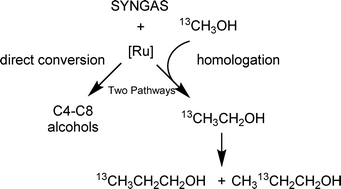Alternative pathways in the ruthenium catalysed hydrogenation of CO to alcohols†
Abstract
CO hydrogenation in [PBu4]Br in the presence of [Ru3(CO)12] gives predominantly methanol, ethanol and propanol with small amounts of 1,2-ethanediol. Using RuO2 as the catalyst precursor, the same products are formed along with higher alcohols (1-butanol –1-heptanol). Reactions carried out using added 13CH3OH or 13CO show that ethanol and propanol come from homologation reactions of methanol and ethanol respectively, but that the higher alcohols are not formed through the lower alcohols as intermediates.


 Please wait while we load your content...
Please wait while we load your content...